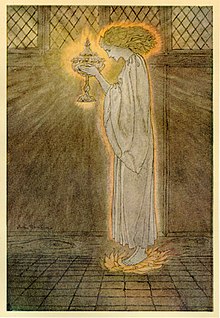
Back الجسد الأثيري Arabic Æterlegemet Danish Ätherleib German Cuerpo etérico Spanish کالبد اثیری Persian Corps éthérique French Corpo eterico Italian エーテル体 Japanese Etherisch dubbel Dutch Prâna Portuguese
| Planes of existence Gross and subtle bodies | |
|---|---|
| Theosophy | |
|
Full list 1. Spiritual/Divine/Logoic/Mahaparanirvanic plane/Adi 2. Spiritual/Monadic/Paranirvanic plane/Anupapaduka
3. Spiritual/Pneuma/Nirvanic/Atmic plane
4. Spiritual/Soul/Causal/Intuitional/Noetic/Buddhic plane 5 Mental/Manasic/Causal/Intellectual plane
| |
| Rosicrucian | |
|
The 7 Worlds and the 7 Cosmic Planes | |
| Thelema | |
| Body of light | Great Work | |
| Hermeticism | |
| Hermeticism | Cosmogony | |
| Surat Shabda Yoga | |
| Cosmology | |
| Jainism | |
| Jain cosmology | |
| Sufism | |
| Sufi cosmology | |
| Hinduism | |
| Lokas/Talas - Tattvas, Kosas, Upadhis | |
| Buddhism | |
| Buddhist cosmology | |
| Gnosticism | |
| Aeons, Archons | |
| Kabbalah | |
| Atziluth > Beri'ah > Yetzirah > Assiah | |
| Fourth Way | |

The etheric body, ether-body, or æther body is a subtle body propounded in esoteric and occult philosophies as the first or lowest layer in the human energy field or aura.[1][2] The etheric body is said to be in immediate contact with the physical body and to sustain it and connect it with "higher" bodies. It is also said to consist of a finer substance, more pure and composed of smaller particles, than the ordinary matter of the physical plane.[3] (See the book Occult Chemistry by C.W. Leadbeater)
The English term "etheric" in this context seems to derive from the Theosophical writings of Madame Blavatsky, but its use was formalised by C.W. Leadbeater[4] and Annie Besant[5] due to the elimination of Hindu terminology from the system of seven planes and bodies. (Adyar School of Theosophy).
The term gained some general popularity after World War I, Walter John Kilner having adopted it for a layer of the "human atmosphere" which, as he claimed in a popular book, could be rendered visible to the naked eye by means of certain exercises.[6]
The classical element Aether of Platonic and Aristotlean physics continued in Victorian scientific proposals of a Luminiferous ether as well as the cognate chemical substance ether. According to Theosophists and Alice Bailey the etheric body inhabits an etheric plane which corresponds to the four higher subplanes of the physical plane. The intended reference is therefore to some extremely rarefied matter, analogous in usage to the word "spirit" (originally "breath"). In selecting it as the term for a clearly defined concept in an Indian-derived metaphysical system, the Theosophists aligned it with ideas such as the prana-maya-kosha (sheath made of prana, subtle breath or life-force) of Vedantic thought.
In popular use it is often confounded with the related concept of the astral body as for example in the term astral projection - the early Theosophists had called it the "astral double". Others prefer to speak of the "lower and higher astral".
- ^ Quillen, Frank W. (1979). "The Ethereal Body as a Means of Survival". Process Studies. 9 (2): 30–34. doi:10.5840/process197991/213.
- ^ Brennan, Barbara, Hands of Light : A Guide to Healing Through the Human Energy Field (Etheric body Archived 2005-04-07 at the Wayback Machine), Bantam Books, 1987
- ^ Powell, A.E. The Solar System London:1930 The Theosophical Publishing House (A Complete Outline of the Theosophical Scheme of Evolution) See "Lifewave" chart (refer to index)
- ^ Leadbeater, C. W., Man, Visible and Invisible, 1902
- ^ Besant, Annie, Man and His Bodies, 1911
- ^ Kilner, Walter J., The Human Atmosphere, or the Aura Made Visible by the aid of Chemical Screens, 1911, reprinted as "The Human Aura" by Citadel Press, NY, 1965, ISBN 0-8065-0545-1. The Aura, by Walter J. Kilner. Introd. by Sibyl Ferguson. New York, S. Weiser, 1973.
© MMXXIII Rich X Search. We shall prevail. All rights reserved. Rich X Search